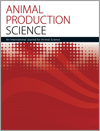
Animal Production Science
Volume 62 Number 16 2022
The welfare of beef cattle produced in Australia is becoming increasingly important to both producers, citizens and consumers. To demonstrate commitment to improving the lives of cattle, the industry needs to identify where it currently stands on cattle welfare, and to demonstrate industry-wide improvements. Welfare benchmarking is a management tool that has the potential to achieve this by providing clear, meaningful data on welfare and by using peer-to-peer comparisons to incrementally drive the average performance upward along the welfare continuum.
AN21573 Abstract | AN21573 Full Text | AN21573PDF (1.1 MB) Open Access Article
AN22054Selection criteria for frame score and its association with growth-, reproductive-, feed efficiency- and carcass-related traits in Nellore cattle
 , E. Peripolli
, E. Peripolli  , R. Espigolan, M. Londoño-Gil, J. D. Rodriguez, L. Brunes
, R. Espigolan, M. Londoño-Gil, J. D. Rodriguez, L. Brunes  , C. U. Magnabosco, N. C. Guimarães, R. D. Sainz, A. S. C. Pereira, R. B. Lobo and F. Baldi
, C. U. Magnabosco, N. C. Guimarães, R. D. Sainz, A. S. C. Pereira, R. B. Lobo and F. Baldi
The specific frame score prediction equation developed for Nellore cattle could be an auxiliary tool to improve mating decisions based on feed resources and production-system objectives. The results support the concept that under unrestrictive nutritional management conditions, a favourable relationship between frame score and beef production is expected; nevertheless, under irregular feed supply, range conditions and cow–calf systems, it is important to control the frame size due to potential genetic antagonism between fertility and reproductive traits with frame score.
Deer antlers are famous traditional Chinese medicine and a unique model for the most rapid cartilage formation and remodelling in mammals. However, the molecular mechanism underlying regulation of this phenomenon is still unknown; in this study, we successfully constructed the miRNA–mRNA regulatory network for the antler cartilage development, and validated it. We believe that our work has laid the foundation for rapid repair of cartilage defects in clinics and for increasing the output of antler production.
AN22133Effects of melatonin in the maturation medium on developmental competence of bovine oocytes exposed to heat shock and on embryo quality

Among the many challenges, the increase in global temperature is a prominent interference in reproductive processes in dairy cattle, since it has deleterious effects on gametes. Therefore, strategies such as the use of substances that reduce the damage caused by thermal stress have been widely used in scientific experiments. In the present study, the use of the antioxidant melatonin in the in vitro maturation medium of heat-stressed bovine oocytes was able to improve embryo quality.
Second parity syndrome is a major reason for culling sows depending on the bodyweight and energy level balance during the first lactation. Our research revealed that early inseminated gilts had a lower bodyweight loss during lactation without showing any adverse effects on litter size and litter growth, which in the long term may positively impact culling age. This information may guide swine farmers on the most appropriate age to breed gilts at first service for increased reproductive life.
AN21150Partial cholecalciferol replacement with 1,25-dihydroxycholecalciferol glycoside in diets for piglets
 , Liliana Bury de Azevedo dos Santos, Isabela Ferreira Leal, Gleicianny de Brito Santos, Paulo Evaristo Rupolo, Ricardo Vianna Nunes, Eduardo Raele de Oliveira and Paulo Levi de Oliveira Carvalho
, Liliana Bury de Azevedo dos Santos, Isabela Ferreira Leal, Gleicianny de Brito Santos, Paulo Evaristo Rupolo, Ricardo Vianna Nunes, Eduardo Raele de Oliveira and Paulo Levi de Oliveira Carvalho
The importance of vitamin D has been well elucidated over the years. However, its importance was demonstrated when animal breeding was intensified and housed in a closed and artificial environment, in addition to genetic improvement, with an intense development of the bone system and accelerated weight gain. Little research related to vitamin D has been conducted in this animal species, especially using the glycoside form, highlighting the importance of this study.
AN21193Effect of litter system and nest box type on egg production and performance of Ross 308 broiler breeders
The litter system is one of the important factors influencing the efficiency of broiler breeder rearing. The influence of the litter system on body weight, feed intake, egg weight and bird mortality was assessed. Results showed poorer incubation in eggs from hens in the deep litter system, compared to eggs from hens in the deep litter and slat system. The scarcity of studies in this field indicates the need to continue research in the future.
Both quantity and quality of meat should be considered in livestock meat production. Meat quality and fatty acid composition of intact and castrated Angora kids at different slaughter weights were studied in Turkey, where the average income obtained from meat is much higher than from mohair yield. Castration of Angora kids affected meat chemical composition (increased protein and fat), as did increasing slaughter weight, which also improved fatty acid composition.
Feeding extruded linseed as 15% DM in the concentrate diet of Rubia Gallega heifers led to non-significant increases in α-linolenic acid (18:3n-3), a lower n-6/n-3 ratio and a decrease in levels of trans isomers of C18:1 other than vaccenic acid in meat while maintaining overall meat and carcass quality and growth rates.
Understanding the total mass and movement of feed particles through the digestive tract of ruminants will assist managers in mitigating enteric methane emission. We evaluated two software programs for fitting parameters to one- and two-compartment digesta kinetic models with empirical faecal-marker datasets to quantify the total mass and movement of feed particles. Model parameters and digesta kinetics estimates derived from either software program can be used in nutritional modelling without concern of creating a bias through software selection.



